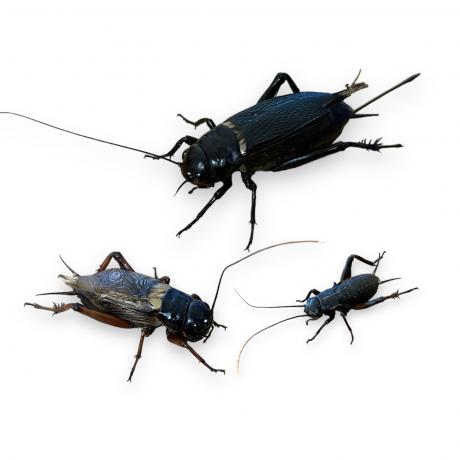

Black crickets or field crickets are one of the most popular feeder insects for exotic pets. These crickets are bold and actively sit out in the open making easy prey for a variety of species. Available in 7 different sizes.
Black crickets are a stocky insect reaching around 25mm in length. As their name suggests, they are black in colour, and have long hind legs meaning they can jump short distances. Visually the sexes are different; the adult males have brown wings (though flightless) which are used to chirp by rubbing them together to attract a mate. Females are generally stockier and have a long ovipositor tube at the rear, which they use to lay their eggs.
Native to Southern Europe, Africa and Asia.
Our crickets are bred in a modern, ethical facility, reared on high end food; meaning that they arrive to you fresh and in excellent health.
Your crickets will arrive in ventilated pre-pack tubs (or bulk bags depending on the quantity you order) with cardboard inside to increase the available area within the tub. On arrival, they may appear immobile if temperatures are low but will soon become active when warm again.
Storing at room temperature around15-24°C is perfect for this species.
In order to get the best from your bugs, we recommend that you move your feeder insects into larger, well ventilated, species specific tubs (i.e don’t mix Crickets and Locusts). Offering more space makes feeding and watering them easier, keeps them alive for longer and conveniently, makes them easier to catch.
It is recommended to both gut load and hydrate your feeder insects for at least 24 hours prior to offering as prey. Gut loading means feeding the insects nutrient rich foods, prior to feeding them to your animal. This ensures maximum nutrition is being transferred from your feeder insects to your reptile, amphibian or arachnids. Dehydrated insects will not absorb nutrients as easily, become weak, lethargic and die off prematurely. For feeding, potato or carrot offers basic nutrition and moisture. The best option is to offer them one of the specialist high quality insect diets; It makes perfect sense that well fed, hydrated feeder insects are far healthier and more nutritious for your pet.
They are packed with moisture, high in protein but low in fat; making them an excellent staple food for your exotic pets (especially when Gut Loaded and dusted with calcium and multivitamins).
Black Crickets are a robust species well suited to a variety of vivarium and terrarium conditions. They are slower moving, less jumpy and easier to catch than other cricket species. Bearded Dragons, Leopard Geckos, Tree Frogs, Tarantulas and many more readily accept Black Crickets as a staple food source. They are available in a variety of sizes to cater for the nutritional requirements of species at different weights and stages of development.
These crickets prefer hot environments and will actively bask out in the open during the day rather than hiding, thus making them easy prey for your reptile to hunt. They are also tolerant of colder temperatures and high humidity environments making them suitable for a wide range of species to feed on. They tend to avoid open water in the vivarium and are less prone to drowning in water dishes than other species of feeders.
Adults are likely to chirp or ‘sing’ to attract a mate and establish territory- especially in warmer environments and these vibrations are known to trigger a feeding response in many species.
The quantity you feed to your exotic pet is entirely species and age dependent. We advise researching the dietary requirements for your pet (or contacting us if you need advice) As a guideline, aim to feed what your pet will eat in one sitting, rather than having lots of uneaten crickets running around your vivarium. An abundance of uneaten prey items will potentially stress out your reptile and can cause possible issues during moulting (especially for invertebrates).
We recommend feeding as part of a varied diet, as with any livefood, variety is the key to providing a well balanced, nutritious diet to compensate for eating a less varied diet than their wild ancestors.The addition of calcium and vitamins is recommended to enhance the nutritional content of these insects. The easiest method for coating your livefood is to put a little supplement powder in a zip-lock bag, add the insects and gently shake. Use some forceps to transfer the livefood into your enclosure. This way, you are not wasting your supplements and only dusting the insects needed per feed.